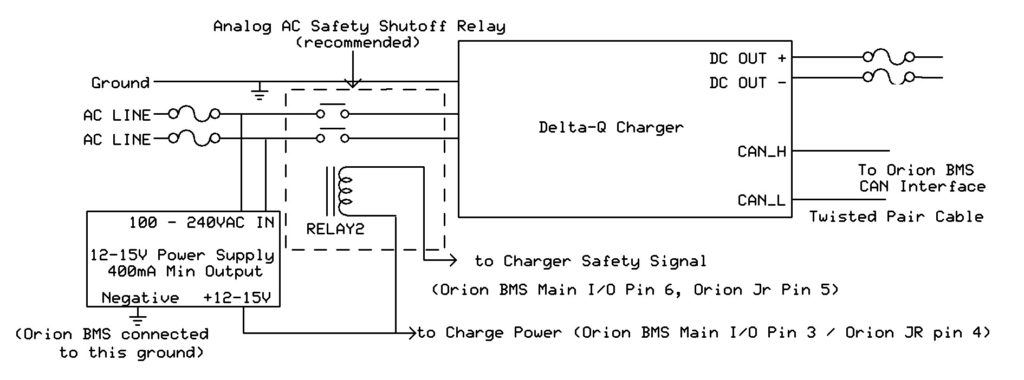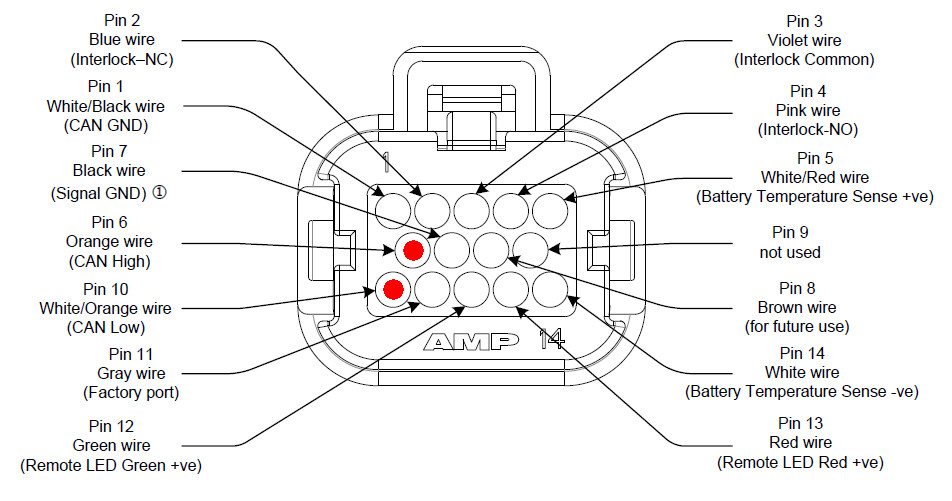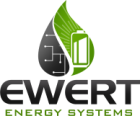Disclaimer: The following information is provided as a guide for integrating Orion BMS products with the Delta-Q chargers. While the information here is believed to be correct, it is the user’s responsibility to verify all aspects of the end application and the suitability of the following. Ewert Energy has no affiliation with Delta-Q and provides this information for informational purposes only and is not responsible for changes in specifications made by the manufacturer. Consult the full user manuals for both products for more information.
The Delta-Q chargers must be controlled via the CANbus interface to operate. At the time this document was written, Delta-Q offers a variety of chargers in multiple product series for a variety of different battery pack voltage and output power ranges.
Ordering the charger
When ordering a Delta-Q IC series charger, ensure that the correct voltage range is ordered.
In addition to specifying the correct pack voltage, it is also important for the charger to be configured correctly (Delta-Q IC series chargers are programmable and can be configured for a number of different applications or controllers). This ensures that the charger has the proper software settings loaded so it can communicate with the Orion BMS / Orion JR.
If possible, the charger should be ordered with the “EWE01-C003” configuration pre-loaded. This allows the BMS to communicate with the charger out of the box and is a custom configuration provided by Delta-Q directly specifically for Ewert Energy customers using the Orion BMS / Orion JR.
If the charger was already ordered without the above configuration pre-loaded, it is possible to reflash the configuration settings on the charger using the instructions below:
How To Update IC Series Delta-Q Chargers Via USB
Link to the recommended EWE01-C003 configuration file:
DELTAQ-EWE01-C003-CONFIG-IC650 (IC650 Charger: 500 Kbps CANBUS)
DELTAQ-EWE01-C003-CONFIG-IC900 (IC900 Charger: 500 Kbps CANBUS)
DELTAQ-EWE01-C003-CONFIG-IC1200 (IC1200 Charger: 500 Kbps CANBUS)
It is also possible to change the default baudrate on the charger using the following upgrade configuration files:
Delta-Q authorized distributors
The following companies are listed as authorized distributors for Delta-Q products and will be best able to assist in purchasing these chargers (Ewert Energy Systems is not affiliated with any of these companies):
Howland Technology
8129 North Austin Ave
Morton Grove, IL 60053
Phone 1-847-965-9808
www.howlandtechnology.com
Fullriver Battery USA
3832 Mission Oaks Blvd. Ste. A
Camarillo, CA 93012
Phone 1-800-522-8191
www.fullriverbattery.com
Interfacing with the charger
Interfacing the Delta-Q IC series charger to the Orion BMS / Orion JR is done through the CANBUS. An optional analog safety shutoff is very strongly recommended unless another backup shutdown method is provided. The following diagram shows the standard configuration.

In this diagram, the CAN connection on the Delta-Q charger is connected to either the CAN1 or CAN2 interface on the Orion BMS (if this is being used with the Orion JR then only CAN1 is possible). A CANBUS requires exactly two 120 ohm termination resistors at the physical ends of the BUS. Unless the Orion BMS was special ordered with a different configuration, the Orion BMS has an internal termination resistor on the CAN1 interface and no termination resistor on the CAN2 interface. The Orion JR will by default have an internal termination resistor loaded on CAN1 as well (CAN2 is not available on the Orion JR). At the time of this writing, the Delta-Q charger does have an internal CANBUS termination resistor loaded in most cases, however, the installer should verify this with an Ohmmeter prior to installation. Please see the wiring manual for more information about proper termination of the CAN bus and for wire length limits for CAN nodes.
The Delta-Q IC series charger comes configured by default to operate at the 500Kbps baud rate (with software configuration EWE01-C003), although it can be configured for other frequencies by flashing new configuration settings. The CAN interface(s) on the Orion BMS / Orion JR can be changed to operate at any of the supported baud rates. Please note that it is very important that all devices on a CANBUS network operate at the same baud rate.

The following pins are used on the Delta-Q IC series charger connector when interfacing with the BMS:
- [Pin 6] Orange – CAN High
- [Pin 10] White/Orange – CAN Low
Please note that the specific color of the wires may vary depending on where the control harness was manufactured. The above colors are the manufacturers recommended colors.
It is strongly recommended that an analog (secondary) shutoff for the charger be provided by adding an AC relay. The charger is primarily controlled using the CAN interface. While CAN is itself a robust protocol, it is still a digital protocol which can be susceptible to errors and bus lockups. An analog backup can turn off the charger even if communication errors are present on the CAN bus such that the batteries are always kept in a safe state. The recommended method of analog backup for this version of the charger is interrupting the AC power to the charger.
Because the Delta-Q IC series chargers can be used on split phase connections (standard residential 240V AC), both AC “hots” must be interrupted using a double pole relay. The relay coil must be less than 175mA for the original Orion BMS (older model with black enclosure) and Orion JR (all models), or less than 500mA when used with the Orion 2 BMS (newer model with silver enclosure). We recommend over-sizing the relay to ensure it can properly handle the AC current. It is up to the user to verify that the relay used is a suitable relay for the application and that the relay meets any necessary specifications (eg: the relay must be properly sized for the anticipated voltage and current).
If using an AC relay is not possible (for example, when being used in an offboard charging application), a DC based contactor may be used instead. NOTE: DC based contactors may require a dedicated pre-charge circuit to prevent excessive inrush current.
Configuring the BMS
The Orion BMS and Orion JR utility both have built in support for the Delta-Q IC series charger CAN protocol making it very easy to enable support for them.
Steps for configuring the BMS to communicate with the Delta-Q Charger:
1.) Open the Orion BMS software utility and load the appropriate profile into the editor by either downloading the existing settings from the Orion BMS (“Recieve Current Profile From BMS”) or by opening a profile previously saved to disk.
2.) On the “Battery Profile” tab, select the “CANBUS Settings” tab and select the Checkbox next to “Delta-Q Charger” in the dialog at the bottom. Enabling this checkbox will popup a dialog that explains changes made to the profile and asks for confirmation. Click OK after reading.
3.) Manually ensure the proper baud rate for the CAN interface connected to the Delta-Q charger. This can be verified on the “CANBUS Settings” tab and select the proper baud-rate for the CANBUS interface that the Delta-Q Charger is connected to (usually 500kBps.) Note: If changing the baud rate, ensure that all devices on the selected CANBUS interface operate at the same speed. CANBUS baud rate changes only take effect when the BMS is reset or power cycled. Please note that if connecting to the BMS via CANBUS that the baud rate may now be different when reconnecting.
4.) After verifying all profile settings, upload the new settings to the BMS.
The Delta-Q charger setup should be thoroughly tested before being left alone to ensure that the CANBUS control is working properly.
Delta-Q Specific Troubleshooting:
If the charger does not charge when connected to the Orion BMS:
- Ensure that the BMS is calling for charge. Connect to the Orion BMS / Orion JR using the BMS utility and monitor the charge current limit (CCL) to ensure that the BMS is allowing charge. Certain error codes on the BMS will prohibit charging! If error codes are present, look up the codes in the troubleshooting guide to troubleshoot these first. The troubleshooting guide is available on the Troubleshooting Page.
- Ensure that the BMS is able to communicate with the charger via CANBUS. With the CANdapter connected to the same CAN interface as the Delta-Q charger, open the Orion BMS utility, select the “3rd Party Data” tab at the top. Select the Delta-Q Charger from the drop down menu and click “Connect to device”. If the CANBUS is operating correctly, data will show up from the charger such as AC voltage. If this data is not present, the charger is either off or there may be a CAN wiring issue preventing the charger from communicating.
Please see the troubleshooting guide for more information which is available on the Troubleshooting Page.
Important: After making any changes to the charger configuration it is very important to test the setup while closely monitoring the battery pack to ensure that the charger turns off properly at the correct time.
![]() AN2825 - Copyright (C) 2019 Ewert Energy Systems
AN2825 - Copyright (C) 2019 Ewert Energy Systems

 AN2825
AN2825





